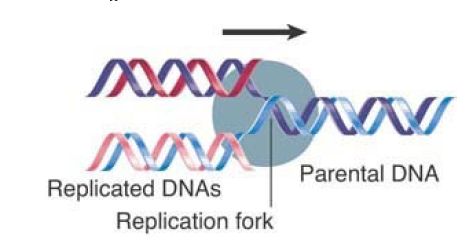
Polymerases Act on Separated DNA Strands at the Replication Fork
 المؤلف:
JOCELYN E. KREBS, ELLIOTT S. GOLDSTEIN and STEPHEN T. KILPATRICK
المؤلف:
JOCELYN E. KREBS, ELLIOTT S. GOLDSTEIN and STEPHEN T. KILPATRICK
 المصدر:
LEWIN’S GENES XII
المصدر:
LEWIN’S GENES XII
 الجزء والصفحة:
الجزء والصفحة:
 25-2-2021
25-2-2021
 2103
2103
Polymerases Act on Separated DNA Strands at the Replication Fork
KEY CONCEPTS
-Replication of DNA is undertaken by a complex of enzymes that separate the parental strands and synthesize the daughter strands.
-The replication fork is the point at which the parental strands are separated.
-The enzymes that synthesize DNA are called DNA polymerases.
-Nucleases are enzymes that degrade nucleic acids; they include DNases and RNases and can be categorized as endonucleases or exonucleases.
Replication of DNA requires the two strands of the parental duplex to undergo separation, or denaturation. The disruption of the duplex, however, is transient and is reversed, or undergoes
renaturation, as the daughter duplex is formed. Only a small stretch of the duplex DNA is denatured at any moment during replication. (“Denaturation” is also used to describe the loss of functional protein structure; it is a general term implying that the natural conformation of a macromolecule has been converted to some nonfunctional form.)
The helical structure of a molecule of DNA during replication is illustrated in FIGURE 1. The unreplicated region consists of the parental duplex opening into the replicated region where the two daughter duplexes have formed. The duplex is disrupted at the junction between the two regions, which is called the replication fork. Replication involves movement of the replication fork along the parental DNA, so that there is continuous denaturation of the parental strands and formation of daughter duplexes.

FIGURE 1. The replication fork is the region of DNA in which there is a transition from the unwound parental duplex to the newly replicated daughter duplexes.
The synthesis of DNA is aided by specific enzymes (called DNA polymerases) that recognize the template strand and catalyze the addition of nucleotide subunits to the polynucleotide chain that is being synthesized. They are accompanied in DNA replication by ancillary enzymes such as helicases that unwind the DNA duplex, primase that synthesizes an RNA primer required by DNA polymerase, and ligase that connects discontinuous DNA strands.
Degradation of nucleic acids also requires specific enzymes: deoxyribonucleases (DNases) degrade DNA, and ribonucleases (RNases) degrade RNA. The nucleases fall into the general
classes of exonucleases and endonucleases:
Endonucleases break individual phosphodiester linkages within RNA or DNA molecules, generating discrete fragments. Some DNases cleave both strands of a duplex DNA at the target site, whereas others cleave only one of the two strands. Endonucleases are involved in cutting reactions, as shown in FIGURE 2.

FIGURE 2. An endonuclease cleaves a bond within a nucleic acid. This example shows an enzyme that attacks one strand of a DNA duplex.
Exonucleases remove nucleotide residues one at a time from the end of the molecule, generating mononucleotides. They only act on a single nucleic acid strand and each exonuclease proceeds in a specific direction; that is, starting either at a 5′ or a 3′ end and proceeding toward the other end. They are involved in trimming reactions, as shown in FIGURE 3.

FIGURE 3. An exonuclease removes bases one at a time by cleaving the last bond in a polynucleotide chain.
 الاكثر قراءة في مواضيع عامة في الاحياء الجزيئي
الاكثر قراءة في مواضيع عامة في الاحياء الجزيئي
 اخر الاخبار
اخر الاخبار
اخبار العتبة العباسية المقدسة


